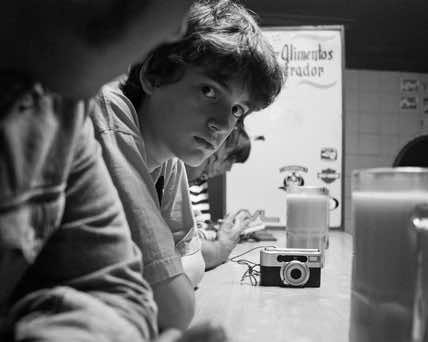 Balancing humor and poetically stunning black and white cinematography, Güeros tells the story of two brothers: Sombra (Tenoch Huerta) and young Tomás (Sebastián Aguirre). After one too many pranks in his native Veracruz, their single mother sends Tomás to live with his mellow slacker of an older brother in Mexico City. Sombra shares an apartment with Santos (Leonardo Ortizgris), who has an anger problem. When the teenage Tomás arrives in Mexico City, he soon realizes that Sombra and Santos may be even more clueless than he. They live in a dilapidated apartment that does not have electricity and are enrolled in the public university (UNAM), which is in the middle of a long strike, which took place in 1999 and lasted almost a year. The title, Güeros refers to a slang word intended to mean “blonde” or “lighter skinned,” which, depending on circumstances, is used derisively to refer to someone who does not belong in a specific social context.
Balancing humor and poetically stunning black and white cinematography, Güeros tells the story of two brothers: Sombra (Tenoch Huerta) and young Tomás (Sebastián Aguirre). After one too many pranks in his native Veracruz, their single mother sends Tomás to live with his mellow slacker of an older brother in Mexico City. Sombra shares an apartment with Santos (Leonardo Ortizgris), who has an anger problem. When the teenage Tomás arrives in Mexico City, he soon realizes that Sombra and Santos may be even more clueless than he. They live in a dilapidated apartment that does not have electricity and are enrolled in the public university (UNAM), which is in the middle of a long strike, which took place in 1999 and lasted almost a year. The title, Güeros refers to a slang word intended to mean “blonde” or “lighter skinned,” which, depending on circumstances, is used derisively to refer to someone who does not belong in a specific social context.
The loose narrative that Director Alonso Ruizpalacios utilizes emphasizes the natural flow of the story, which touches on several themes, including inequality in Mexico, the complexity of the mega city, the challenges of public education and the feeling of loss the two brothers still feel after their father’s passing. The beginning of the movie shows several idle moments of aimlessness. For starters, the strike at the University speaks to the idleness and lost moments of Sombra and Santos, who are not engaged in a direct way and seem to be wasting away – as many of those who endured that strike did (they choose to go on “strike against the strike”).
The arrival of Tomás changes this dynamic, however, as the young kid is full of energy and nostalgia for those days when their dad was around. He carries a tape that his father gave him by one of the best musicians in Mexican rock history, an  allegory for the golden days. He finds that this mythical musician is still around but is close to death, which gives the trio an excuse to venture out from their home. Ruiz Palacios shows the impact of this music without ever revealing it via lengthy shots of the characters using headphones to listen to tape and focusing on their reactions that shift from moved to amazed and ends in a deeply affected state. The genius of this strategy is that it allows the music to be part of the characters, not the focus of the film itself.
allegory for the golden days. He finds that this mythical musician is still around but is close to death, which gives the trio an excuse to venture out from their home. Ruiz Palacios shows the impact of this music without ever revealing it via lengthy shots of the characters using headphones to listen to tape and focusing on their reactions that shift from moved to amazed and ends in a deeply affected state. The genius of this strategy is that it allows the music to be part of the characters, not the focus of the film itself.
Throughout their adventure, the three characters find themselves travailing the city, which at times shows a disconnect between them and the variety of characters found in each of the neighborhoods. Güeros’ portrayal of Mexico City is one of the most honest depictions in the film. An ode to one of the most complex cities in Latin America, Güeros explores a journey of self-discovery that parallels an exploration of Mexico City in an intimate, real way.
The film takes on a self-referential and funny turn once the trio end up in the University campus, where the strike is in full swing. One of the protesters turns his attention directly to the camera and starts talking about the film as it is, in a straightforward way, making fun of the film itself. The conversation immerses the audience in the filmmaking process itself and removes the real or perceived barrier between the director and the audience, also doing away with any lengthy expository dialogue. Ruiz Palacios cuts straight through the typical Hollywood conventions and addresses us and his actors in a dialogue devoid of fluff, a narrative that has a sense of humor but questions its social relevance at the same time.
and removes the real or perceived barrier between the director and the audience, also doing away with any lengthy expository dialogue. Ruiz Palacios cuts straight through the typical Hollywood conventions and addresses us and his actors in a dialogue devoid of fluff, a narrative that has a sense of humor but questions its social relevance at the same time.
At the protest, we also meet Ana (Ilse Salas), one of the leaders of the student movement and Sombra’s love interest. The encounter is intense at a personal level but is also one of the key moments that Ruiz Palacios uses to showcase the embedded social inequality that exists in Mexico City. The debates at the university ring so true, it feels like one is experiencing the university on a vividly genuine level, in a script that could have only been written by someone who was personally impacted by that protest. Ruiz Palacios has described in an interview that he was close to attending UNAM when the protest erupted but learned first-hand from friends how it affected hundreds of people who both supported and were against the university takeover.
This self-referential humor happens once more when Sombra has a fit at an elegant party that Ana takes the trio to, and directs a rant to the crowd – and by extension, the film’s audience — about the hypocrisy in Mexican art house films that parade non-trained actors and complain about the country’s ailments abroad. The self-referential awareness of the precarious situation of art that can be at once constructive and destructive reveal a filmmaker who is keenly aware of the sociopolitical issues in Mexico and takes a constructive stand via the same medium he criticizes. This is surely an art-house film that does away with clichés by directly poking fun at them in a playful way.
The black and white film, presented in the 4:3 aspect ratio, combined with the naturalistic acting style speaks to the influence of the French New Wave, but this film is so much more. The narrative encompasses an honest account of a sociopolitical reality that is tough to encapsulate. The film also shows a coming of age of sorts for Sombra, who is alienated and detached at the onset of the film but finds the courage to connect to his little brother, his friend and his love interest throughout the journey to finally come to terms and become part of the world he inhabits. In a nod to 400 Blows, Riva Palacio ends the film with a shot of Sombra who turns around to the camera with an all-knowing gaze that signals growth and a recognition of the self. Güeros never takes itself too seriously but remains a poetic film.
Update: Güeros is coming back to South Florida for an exclusive run in Broward County at the Cinema Paradiso Hollywood. It opens there on July 17 (details here).
Güeros runs 102 minutes, is in Spanish with English subtitles and is not rated (it has cursing, smoking and some sexuality). It opened this past Friday, June 26, in our Miami are at the Coral Gables Art Cinema where it plays until July 2. For dates in other parts in the U.S. and Canada, visit this page, where there are dates scheduled through September. All images are courtesy of Kino Lorber, Inc.










